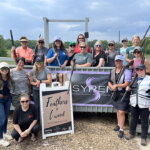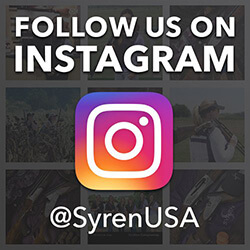Full chokes, skeet chokes, duck loads, target loads, slugs. This is a field that is extremely diverse and quite often difficult to navigate. A quick Google search will yield a plethora of information, but will also inundate a new shooter and often perplex even the most experienced one. I want to preface this entire article with my humble opinion – less is seriously more. I rarely stray from set up and enjoy great success over multiple disciplines and applications. Let’s take a look at what is a choke and what it means to “choke” your gun.
What Is a Choke?
When we try to discover the core meaning of “choke” or “choke tube” or even “shotgun choke” in Merriam-Webster’s dictionary, we are informed that the word doesn’t even exist. That’s how baffling chokes can be. The dictionary doesn’t even know how to explain it. Luckily, we can look toward more expert sources, such as Briley’s website, one of the foremost manufacturers of chokes for a wide array of shotguns. The following is found in bold, large font at the beginning of their choke explanation:
“If you are new to shooting and do not understand shotgun chokes, do not be surprised. Seventy-five percent of shotgun shooters that have shot for many years do not understand shotgun chokes either. Let us start at the beginning. Shotgun chokes were designed to control pattern diameters at different yards. What is a pattern? It is just the grouping of the pellets at a given yardage. This grouping is called a pattern and is measured by a circle diameter. This particular circle must have certain efficiency. In other words, it has to have certain number of pellets in a given area (called distribution) for it to be labeled an efficient pattern. It is that easy! However, the confusion starts when we label them, and you try to figure out what to use and when.”
That seems to set the precedent that this is fairly in-depth and detail oriented and something that will absolutely require a bit of research on your end before you go shoot. You see, we are literally dealing with hundredths or even thousandths of an inch and umpteen variables.
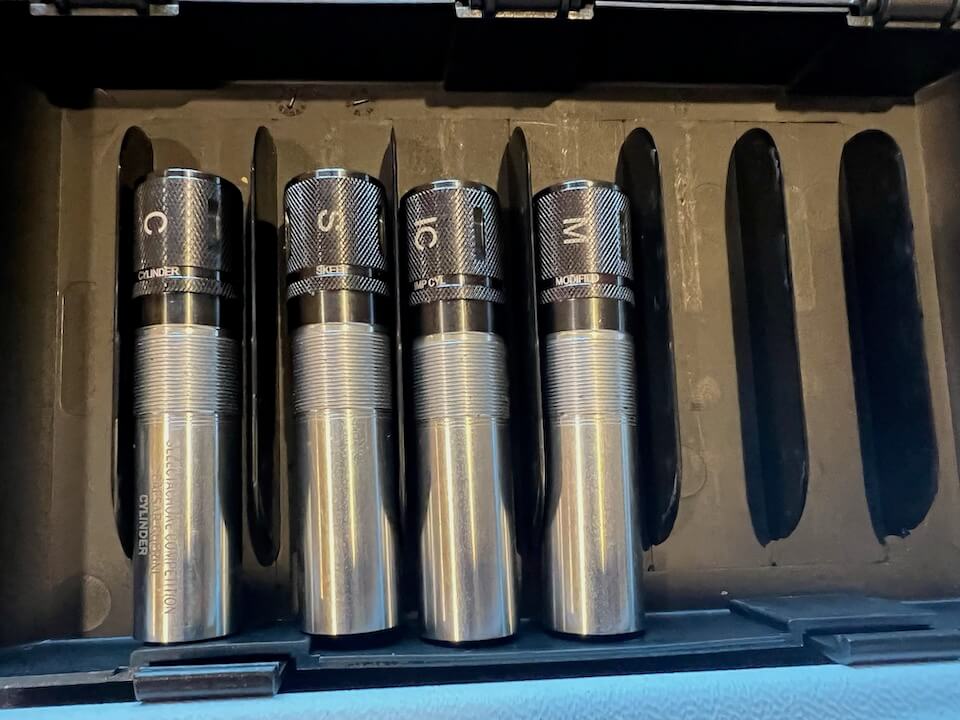
Extended Competition SelectaChoke Tubes by Caesar Guerini
A Note about Caesar Guerini-Made Shotgun Chokes
Caesar Guerini shotgun chokes are made of the same material as their barrels, plus chromed lined for added corrosion protection. The material essentially ensures these chokes expand and contract at the same manor the barrels do, creating an equal and ideal ballistics match for their guns. Doing this is more costly for the manufacturer, but ensures the best possible chokes for their shotguns.
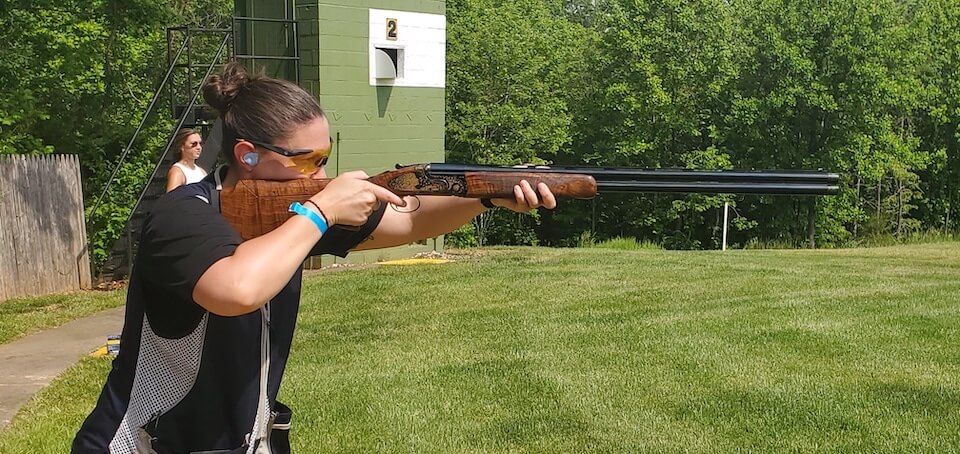
What to Think About When Choosing a Choke
First, are you playing a clay game or are you hunting, and if so, what is your quarry? Skeet requires more open chokes, hence a “skeet” choke, as your bird never changes and the shots are always within 20-to-25 yards, even closer if you are playing “zone,” which means you are shooting the clay within a particular set of boundaries.
If trap is your game, then you will want to do what is known as “choke up” your shotgun for a tighter pattern. Most trap shooters utilize an improved modified or modified choke. Their targets are, on average, about 30-to-35 yards out at distance. As shooters improve, they are given positions farther back on the line, known as a handicap and go from shooting at 16 yards behind the trap house out to as far as 27 yards behind the trap house. The farther the shooter goes back, the tighter the choke gets to help hold the pattern together until the shot reaches the target.
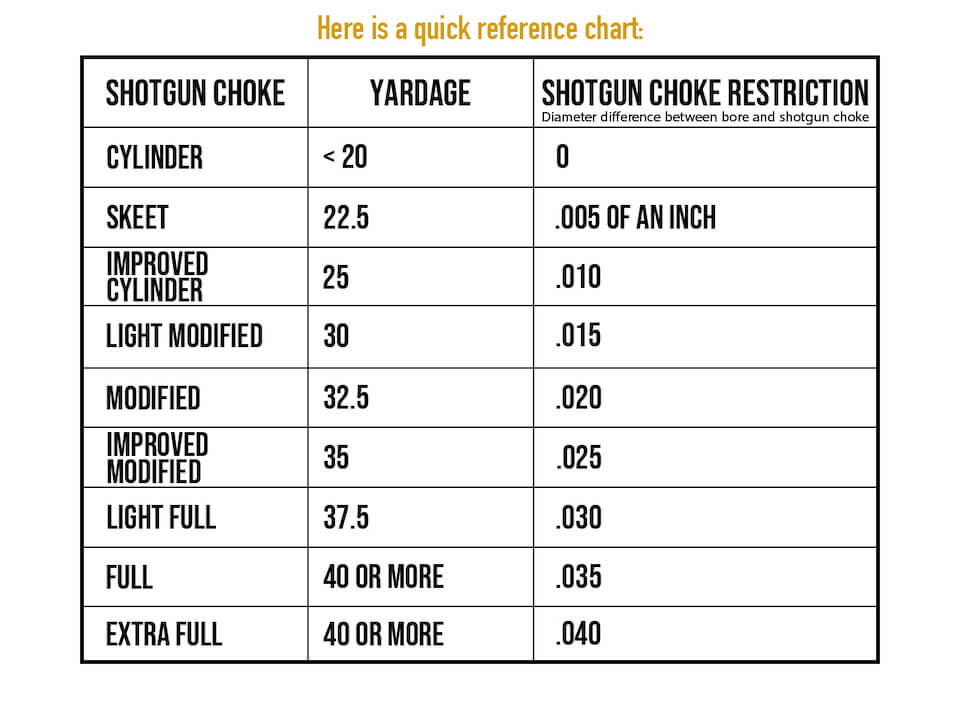
Briley’s choke chart
In the game of sporting clays, you will be faced with any number of presentations and at all varying degrees of yardage – from 10 yards to 60 yards plus! While there is the option to change your chokes out during a competition before you shoot your first pair, most shooters will choke their guns with a modified or improved modified in the top barrel and improved cylinder in the bottom. This will allow them to select the appropriate barrel in relation to their expected presentation. This set up is also what I will usually suggest to 99% of my students. It serves you well across the gamut of shots on any field, regardless of the game and also sets you up for fabulous success in the average hunt scenario. I say average because waterfowl and certain wild birds will require modifications to your set up. (If you think you will be changing your chokes with any regularity, then you may want to explore extended chokes. They are quickly changed without a tool and you can keep the extras in your shooter vest for quick and easy access.)
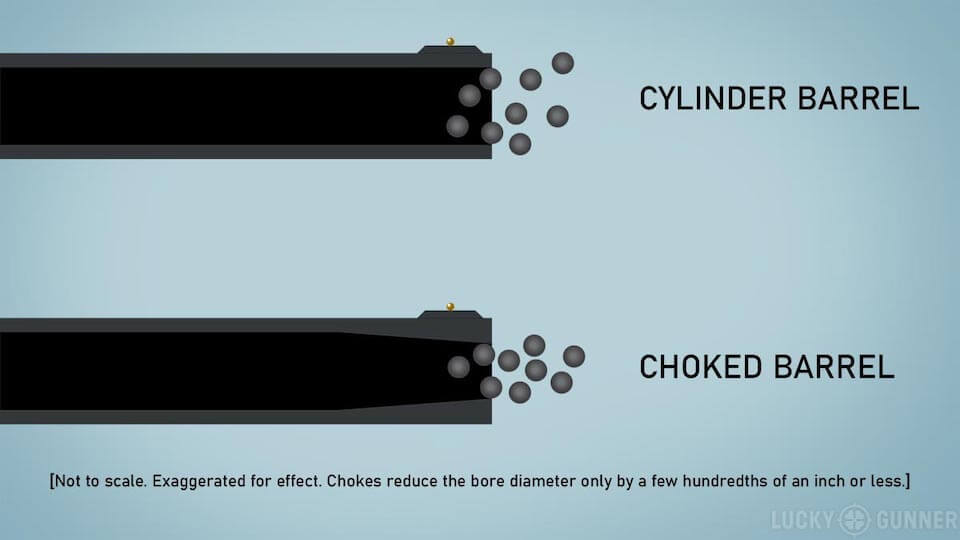
More About Chokes
Now, the nitty gritty on chokes and exactly what they mean to you as a shooter. A shotgun is manufactured with a steel barrel. That barrel just by itself is as open as it gets. In order to control the mass of BBs coming out of the muzzle, you will need to constrict that exit. A series of chokes will allow you to accomplish this constriction with just a few twists. As mentioned above, depending on what game you are playing, you may want to select one choke over another. This is because the farther the BBs fly, the more the pattern opens up and there are holes in the pattern that get bigger and bigger with every fleeting moment. Think of your pattern of BBs as a net. If your target is close, you will want a net to open as quickly and largely as possible to catch your target. If your target is farther away, you need that same net to hold together tighter for longer so that it reaches your target without losing energy and falling apart. This is why understanding choke tubes for your chosen application is important. You will, from time to time, need to adjust your chokes depending on your target and the distance to that target.
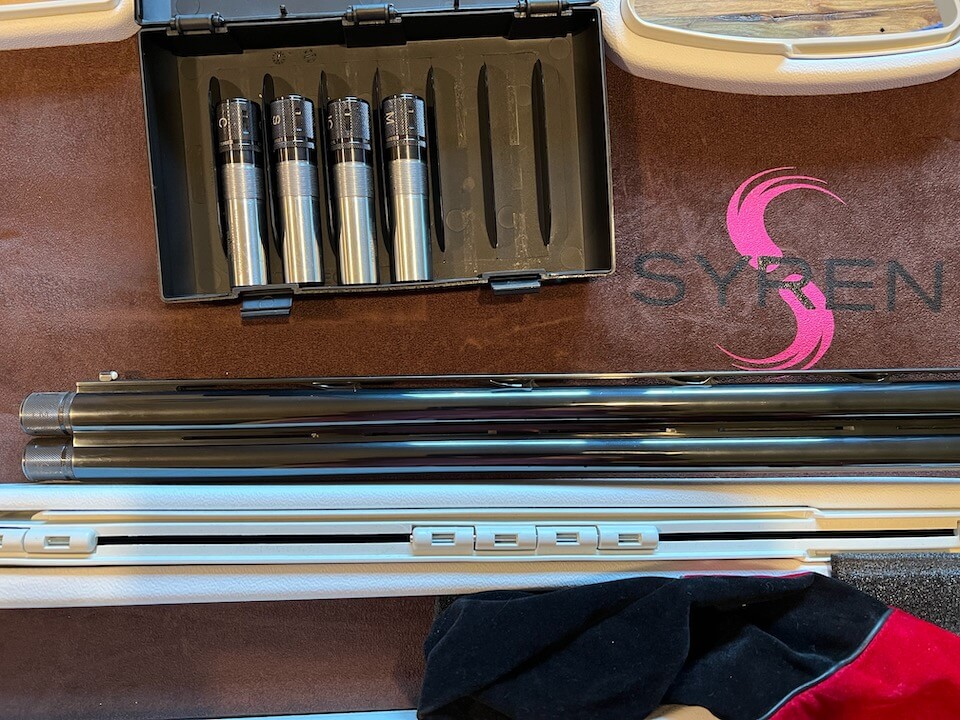
Don’t Forget to Pair a Choke with the Right Ammo
Equally as important as the choke is the ammunition that you put through that choke. Not all ammunition is created equally. We went into more detail about ammunition in last month’s article, but it warrants revisiting for the purposes of choke conversations. This is where taking your gun out to pattern before you shoot clays or hunt is vital. Not all guns like every brand of shells or even every load within that particular brand. I certainly have my favorites, and depending on the gun that I am shooting and the target ahead, I will purposely select one brand and size shot over another.

Don’t Forget to Pattern!
After a miserable debacle on a tundra swan hunt, I will never go out without patterning my gun. Quick aside, my regular waterfowl gun was in the shop for a repair, so I grabbed a backup – that I had never shot much, less patterned! As a result, I saw a beautiful, big swan fly in and then, fly back out of the field, thanks to the atrocious pattern from the recommended shot that the gun I was using obviously abhorred. Pattern you gun, period.
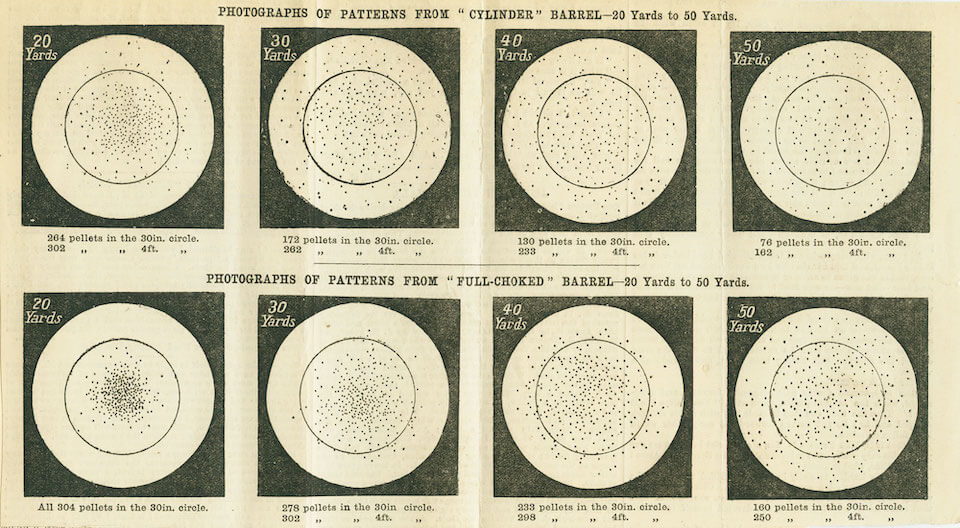
Patterning your gun is quite simple and every gun club and clay course has a patterning board available just for this purpose. All you need is your favorite shotgun, the chokes for that gun, the various loads that you would like to try in the gun, a large piece of paper and marker or a can of white spray paint. I personally use the paper method because I like to save the results and pull them back out to remember which loads work with which chokes and a certain ammo. It comes in very handy for a quick reference prior to a competition or a hunt.
To set up the board with paper, I use cheap magnets to hold my large sheet of plain paper in place on the steel board. On that paper I will draw a 30-inch circle with a two-to-three-inch red dot in the center or crosshairs. For the spray paint method, you are simply spraying the steel plate to cover any previous pellet marks and also adding a center marker with a red dot or crosshairs.
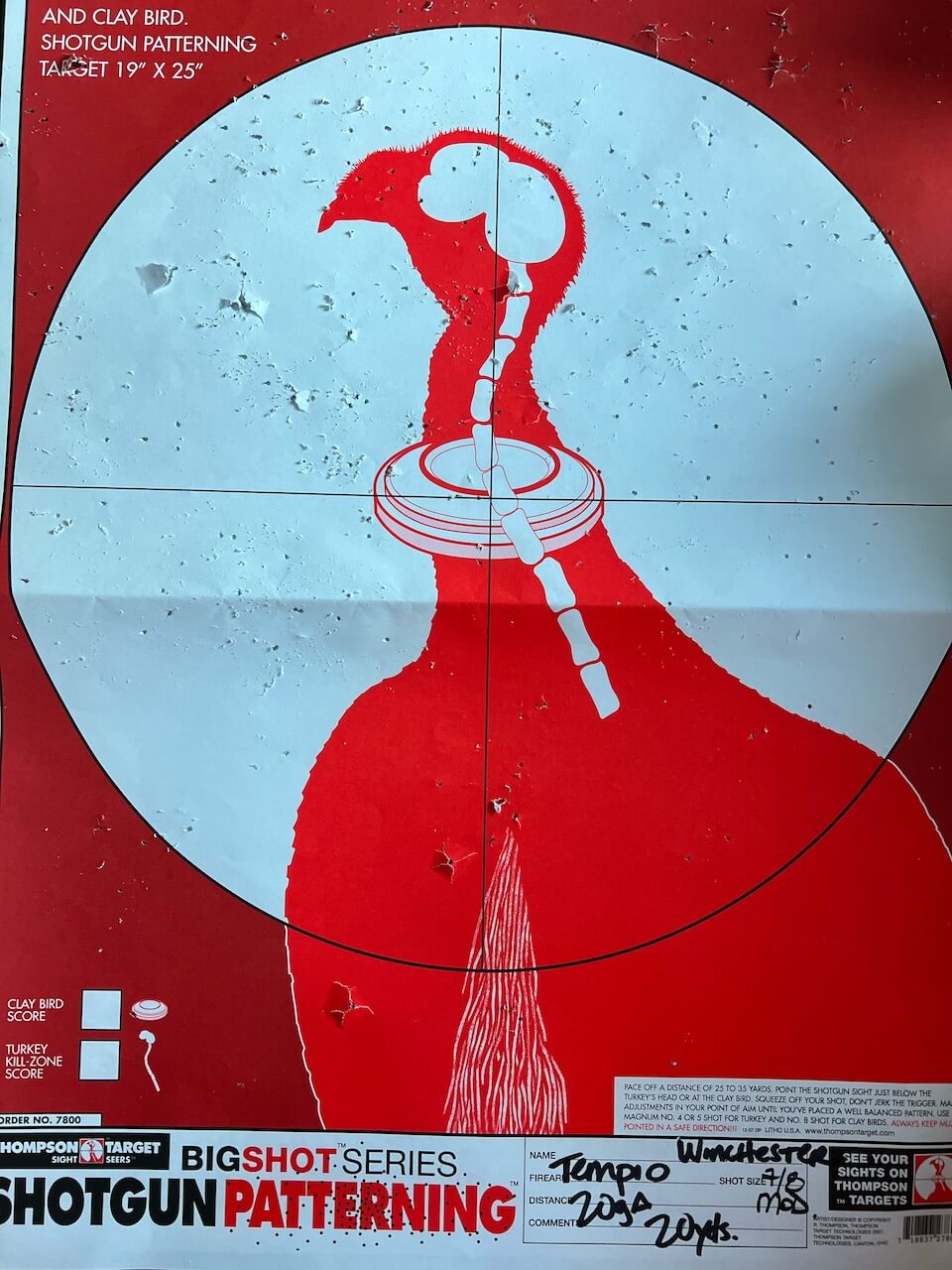
Winchester 7/8oz 1210fps #8 loads
There is much conversation about the distance to stand to perform a pattern test. If you are a trap shooter, it makes sense to do this test at both 16 yards and 27 yards. If you shoot skeet, then 20 yards. For sporting clays and hunters, you will want to pattern at 25 yards and maybe even out to 40 yards. With eye and ear protection in place, of course, hold your gun at a 6 o’clock hold, on the center marker. In other words, have the barrel touching the bottom of that center marker and easily pull the trigger. When you check your target, see how many BBs are in the 30-inch circle. You will also notice if there are pellet marks pulled to one side or the other and if the shot is high or low. Some of this may be shooter error but it is also very telling about your shotgun and especially your fit with that gun. There is a ton of information to be gleaned from a pattern test. It gives you a chance to geek out and really learn the intricacies of your particular firearm. It is hard to ignore issues when they are staring you in the face on that pattern board.
Slow Down the Shot Speed
As a sidenote, bigger and faster is rarely better. Actually, it is usually detrimental to most patterns. The degree of deformation through the barrel goes up with speed and size of those BBs. I cringe at the people that I see willfully shooting 1-1/8-ounce, 1350 fps loads for clays. I mean, if Olympians who are restricted to no more than a 12 gauge, 7/8-ounceat 1200 fps can break clays, then you can certainly squash a clay at 30 yards on the average course. I promise. You just need to make sure you have a well-fitted gun and know your hold points and break points and what to do with the bird at your break point.
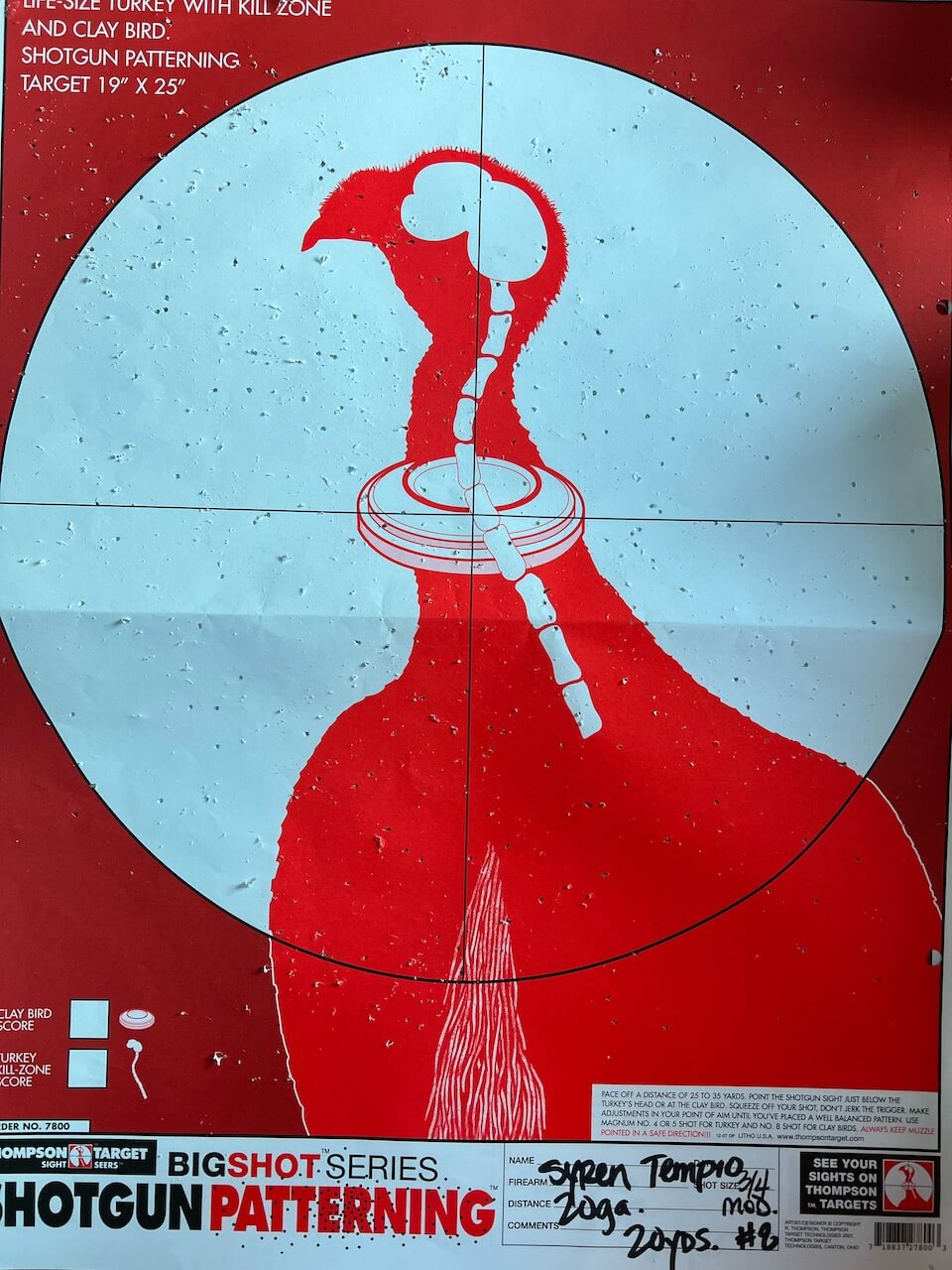
Fiocchi 3/4oz 1210fps #8 loads
We take time to learn any manner of things when it comes to doing things we love. Why wouldn’t you give that same time and consideration to something so important as your success behind the barrel? Be sure to post and share your patterns and let us know your preferred shell with your favorite Syren for the clay course and the hunt field!
Check out Syren’s lineup of fine shotguns and chokes.
Enjoying this post? Read more just like it on our Syren Savvy Blog HERE.
*This article was originally posted in our column on WomensOutdoorNews.com and edited by WON Publisher/Editor Barbara Baird.




